Construction of Al-ZnO/CdS photoanodes modified with distinctive alumina passivation layer for improvement of photoelectrochemical efficiency and stability†
Abstract
ZnO/CdS-based nanorod arrays (NRs) are an excellent class of photoanode materials, which possess high photoelectric response for solar-driven water splitting. A highly efficient photoanode system consisting of Al-doped ZnO NRs as effective electron-transfer layers and CdS as a light harvesting layer was rationally designed. Al doping increased the conductivity of ZnO NRs and simultaneously coarsened the surface of ZnO due to expansion of ZnO lattice. The rough surface favoured the growth of a CdS coating layer on it through a successive ionic layer adsorption reaction. The integrated ZnO/CdS photoanode exhibited photocurrent of 10.4 mA cm−2 at 1.23 V versus RHE (reversible hydrogen potential) and conversion efficiency of 5.75% at 0.38 V versus RHE for 60 SILAR CdS cycles. The coating of a protective Al2O3 passivation layer through the direct current magnetron sputtering technique significantly improved the stability of the electrode, and it was better than that of the conventional atomic layer deposition method.



 Please wait while we load your content...
Please wait while we load your content...